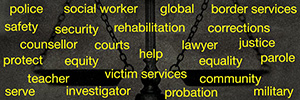- Future Students
- Current Students
- Faculty
- Staff
- Alumni
- Others
UofGH Cool Classes: Canadian Social Problems
Why is this course interesting?
When they enter the workforce, many University of Guelph-Humber Justice Studies students will work with people experiencing societal issues relating to matters such as poverty and income inequality, gender and sexuality, addictions, race and ethnicity, and climate change. The third-year course Canadian Social Problems – created and taught by instructor Dr. Ron Stansfield, and also taught by instructors Jessy Singh and Dr. Nitin Deckha – gives Justice Studies students first-hand exposure to societal issues they will be dealing with in their law enforcement and justice careers.
“Given that our students are all training to work with people in society – whether they’re going to be police officers, corrections officers, social workers, counsellors, or work in border services – they’re going to be dealing with challenges that stem from the way society is organized,” says Dr. Deckha. “So the premise of the course is to deepen their awareness of the various social problems.”
The hallmark of the course is a street walk – a three-to-four hour evening journey in the downtown Toronto area, where students walk in groups and see many social issues up close. “We send the students in and around areas near homeless shelters, near safe injection sites, areas where there was once open prostitution, in and around the Moss Park Armoury on Jarvis Street, to see poverty at its face. Rather than talking about it, we want students to experience it themselves,” says Singh.
Dr. Stansfield, who created the course for UofGH, developed the street walk activity with two colleagues during his time at Humber College. Before becoming an instructor, Dr. Stansfield worked as a police officer for Peel Regional Police, and as a probation officer in Toronto’s Regent Park area. He saw a valuable learning opportunity in allowing students to get first-hand exposure to neighbourhoods like Regent Park through the street walk. “It nicely gives students the opportunity to be exposed – rather than just simply sitting in a classroom and talking about social problems and reading about them in a textbook, I thought it would be much more effective if there was an experiential activity where they could actually see and perhaps even be a participant/observer to some of those social problems as a result of doing the street walk, and over the years it has proven particularly effective,” says Dr. Stansfield.
What will you learn?
With a combination of classroom learning and the street walk experience, students build the critical thinking skills to learn to interconnect the many social problems in Canada. “This course really gives students exposure to some of the frontline, real issues that communities all across this country – more specifically in the GTA – face,” says Singh. “We cover topics such as poverty, substance abuse, inequality, diversity, gender identity, it’s a really great class that gives students a broad range, from a spectrum of what they’re going to expect when they’re interacting with communities.”
“The street walk is like the signature, or the heart of the course,” adds Dr. Deckha. “The beauty of that area of the street walk is it’s walkable, and it’s accessible to students, and within three or four hours they get this manifestation of all these different social problems which we have been studying or will be studying throughout the semester.”
What will you take away?
Through this class, students will take away valuable critical thinking and analytical skills, and will interconnect the various social problems. “In reality a person is not dealing with one issue – they may be dealing with homelessness, but they also might be dealing with drug addiction, mental illness, poverty, and dealing with unemployment – they’re dealing with a whole bunch of different things that come together,” says Dr. Deckha. “Students can connect their observations with the peer-reviewed research with the media they take in – they’ll develop a syncretic ability to synthesize information and knowledge and data, and that is really vital, because that mindset of critical thinking and problem solving is going to be really important when they enter the workforce.”
Singh says students will learn that every problem is unique, and that each person’s experience is different. “I’m hoping all students take away that there’s not a one-size fits all solution to these problems. Solutions have to be created, and they have to be innovative, and responsive of community needs. So I’m looking to expose students to yes, these problems do exist, they exist in downtown cores in big cities. It exposes them to the fact that these are real problems that occur in society today,” he says. “Hopefully by the time they graduate they can reflect on what they learned in the Canadian Social Problems course and cater their approach to what they’ve learned in the classroom.”
Students will also gain a sense of empathy, which will help them when they are working with communities. “Sometimes students will have encounters on the street walk where people talk to them, so they also have the opportunity for informal learning, where they learn something from a street person,” says Dr. Deckha. “If they engage then they can engage critically, and that truly teaches them how to speak to people empathetically and acknowledge the different realities – those are valuable skills that are supported by the placements they do and their volunteer work, but it knits the Justice Studies program together.”
“Inevitably experiential learning activities like the street walk are so powerful because they force us to confront our fears,” agrees Dr. Stansfield. “What I’m trying to impart to students in that process is to give them an opportunity to face their fears and see these people as real human beings, rather than a stereotype they may have seen through the media.”







